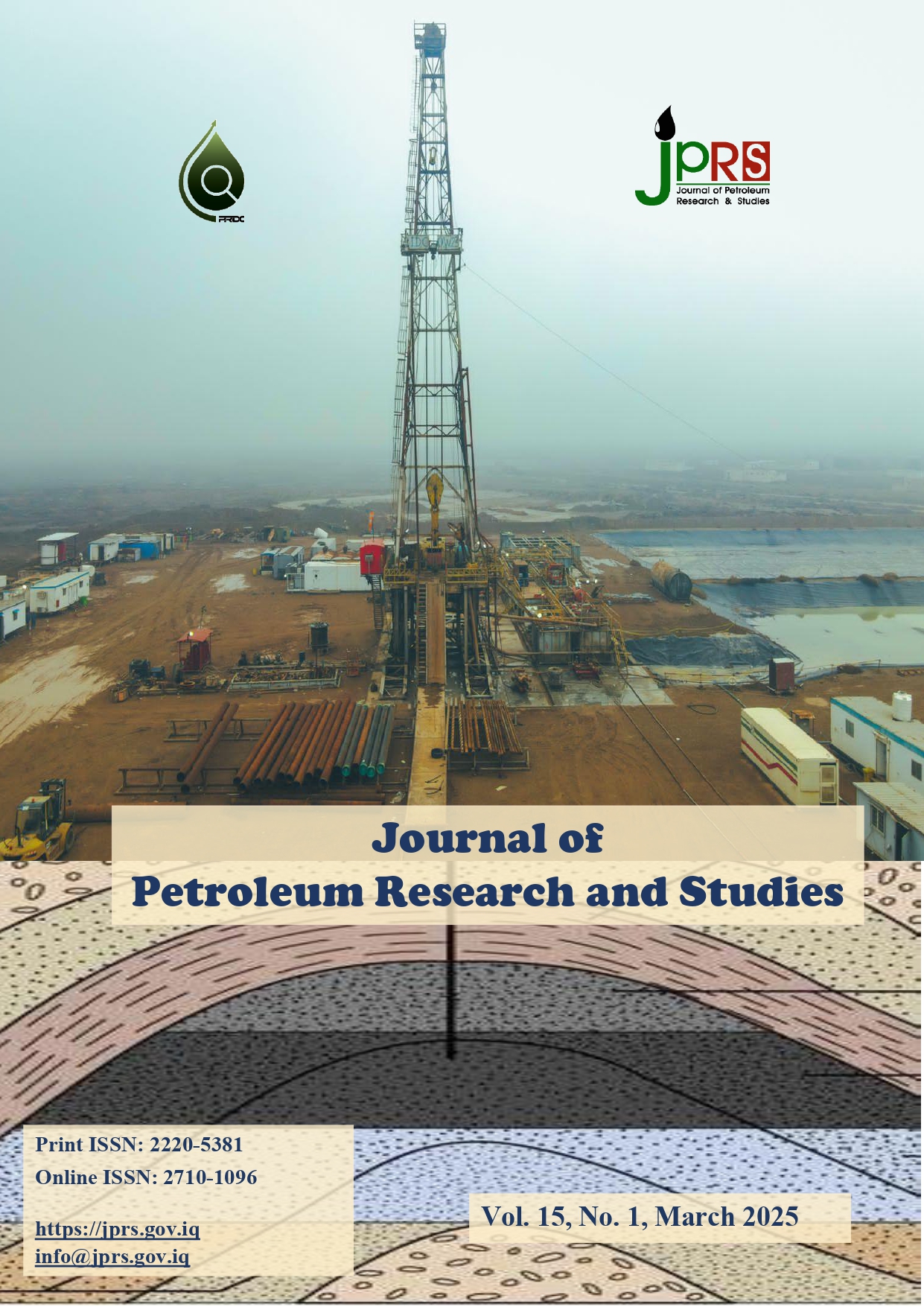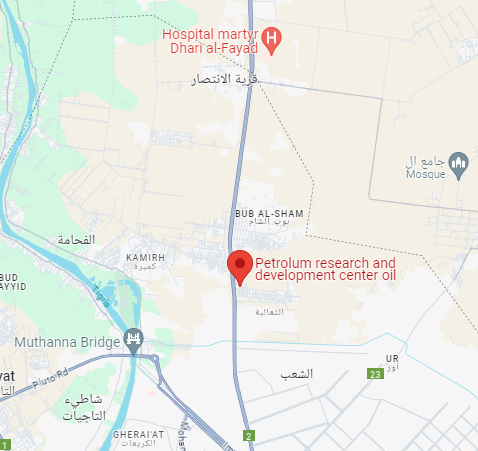حركية إزالة الكبريت بالأكسدة بالبلازما غير الحرارية للنفثا الثقيلة
DOI:
https://doi.org/10.52716/jprs.v15i1.840الكلمات المفتاحية:
desulfurization, non-thermal, plasma, heavy naphtha, oxidation.الملخص
قامت هذه الدراسة باختيار الظروف الامثل لمعالجة نموذج الوقود الذي يحتوي على مركبات الكبريت العضوي (البنزوثيوفين وثنائي بنزوثيوفين) التي تم أكسدتها بواسطة البلازما غير الحرارية. تضمنت العملية توليد الأوزون من خلال عملية التفريغ الكهربائي، يليه الاستخلاص باستخدام الأسيتونيتريل. أظهرت النتائج كفاءة أكسدة وإزالة ثنائي بنزوثيوفين وبنزوثيوفين بواسطة البلازما غير الحرارية. وصلت كفاءة إزالة الكبريت إلى 93.78% في ظل الظروف المثالية، والتي تتضمن جهد 11 كيلو فولت، ودرجة حرارة 50 درجة مئوية، ومدة 4 ساعات، ومعدل تدفق 75 مل / دقيقة. عندما تم أكسدة النفتا الثقيلة في ظل الظروف المثلى، وجد أن إزالة الكبريت كانت 91.082٪. علاوة على ذلك، تم دراسة حركية الأكسدة لهذا النظام، حيث كشفت الدراسات الآلية والحركية المفترضة للأوزون أن إزالة الكبريت التأكسدي لمركبات الكبريت العضوي يمكن أن تقدم حركية زائفة من الدرجة الأولى. وكان ثابت معدل التفاعل للنفثا الثقيلة هو 0.4759 h-1.
المراجع
M. A. Safa, R. Bouresli, R. Al-Majren, T. Al-Shamary, and X. Ma, “Oxidative desulfurization kinetics of refractory sulfur compounds in hydrotreated middle distillates,” Fuel, vol. 239, pp. 24–31, Mar. 2019. https://doi.org/10.1016/j.fuel.2018.10.141.
Ministry of Oil, Republic of Iraq, 2021.
J. M. Campos-Martin, M. C. Capel-Sanchez, P. Perez-Presas, and J. L. G. Fierro, “Oxidative processes of desulfurization of liquid fuels,” J. Chem. Technol. Biotechnol., vol. 85, no. 7, pp. 879–890, Jul. 2010. https://doi.org/10.1002/jctb.2371.
Y. Ding, J. Wang, M. Liao, J. Li, L. Zhang, J. Guo, and H. Wu, “Deep oxidative desulfurization of dibenzothiophene by novel POM-based IL immobilized on well-ordered KIT-6,” Chem. Eng. J., vol. 418, Aug. 2021. https://doi.org/10.1016/j.cej.2021.129470.
G. Zhang, F. Yu, and R. Wang, “Research advances in oxidative desulfurization technologies for the production of low sulfur fuel oils,” Petroleum & Coal, vol. 51, no. 3, pp. 196-207, 2009. [Online], Available: www.vurup.sk/pc.
Y. Mundher, H. Q. Hussein, and B. A. Al-Tabbakh, “Synthesis and characterization of (TBAPW11O39) hybrid Keggin type catalyst,” in AIP Conf. Proc., American Institute of Physics Inc., Nov. 2022, https://doi.org/10.1063/5.0107720.
J. M. Campos-Martin, M. C. Capel-Sanchez, P. Perez-Presas, and J. L. G. Fierro, “Oxidative processes of desulfurization of liquid fuels,” J. Chem. Technol. Biotechnol., vol. 85, no. 7, pp. 879–890, Jul. 2010, https://doi.org/10.1002/jctb.2371.
C. Ma, B. Dai, P. Liu, N. Zhou, A. Shi, L. Ban, and H. Chen, “Deep oxidative desulfurization of model fuel using ozone generated by dielectric barrier discharge plasma combined with ionic liquid extraction,” J. Ind. Eng. Chem., vol. 20, no. 5, pp. 2769–2774, Sep. 2014. https://doi.org/10.1016/j.jiec.2013.11.005.
L. Ban, P. Liu, C. Ma, and B. Dai, “Deep desulfurization of diesel fuels with plasma/air as oxidizing medium, diperiodatocuprate (III) as catalyzer and ionic liquid as extraction solvent,” Plasma Sci. Technol., vol. 15, no. 12, pp. 1226–1231, Dec. 2013. https://doi.org/10.1088/1009-0630/15/12/12
W. Zhang, G. Xie, Y. Gong, D. Zhou, C. Zhang, and Q. Ji, “Non-catalytic oxidative desulfurization of diesel oil using ozone in a biphasic oil/acetonitrile system,” J. Chem. Eng. Jpn., vol. 53, no. 2, pp. 68–72, 2020. https://doi.org/10.1252/jcej.19we095.
M. Alibolandi, J. T. Darian, M. Ghaedian, S. J. Royaee, and A. Shafeghat, “Non-catalytic oxidative desulfurization of gas condensate by ozone and process optimization using response surface methodology,” Korean J. Chem. Eng., vol. 37, pp. 1867–1877, Nov. 2020. https://doi.org/10.1007/s11814-020-0595-1
W. Taher, M. Dr, R. Fareed, K. Almilly, S. Bahjat, and A. Al-Ali, “Desulfurization of diesel fuel by oxidation and solvent extraction,” Journal of Engineering, vol. 21, no. 2, pp. 87–102, Feb. 2015. https://doi.org/10.31026/j.eng.2015.02.06
G. S. Ahmed, J. I. Humadi, and A. A. Aabid, “Mathematical Model, Simulation and Scale up of Batch Reactor Used in Oxidative Desulfurization of Kerosene”, Iraqi Journal of Chemical and Petroleum Engineering, vol. 22, no. 3, pp. 11–17, Sep. 2021. https://doi.org/10.31699/IJCPE.2021.3.2
E. Cako, R. D. C. Soltani, X. Sun, and G. Boczkaj, “Desulfurization of raw naphtha cuts using hybrid systems based on sonocavitation and advanced oxidation processes (AOPs),” SSRN Electron. J., 2021. http://dx.doi.org/10.2139/ssrn.3978295.
N. Kayedi, A. Samimi, M. Asgari Bajgirani, and A. Bozorgian, “Enhanced oxidative desulfurization of model fuel: A comprehensive experimental study,” South African Journal of Chemical Engineering, vol. 35, pp. 153–158, Jan. 2021, https://doi.org/10.1016/j.sajce.2020.09.001.
A. E. S. Choi, S. Roces, N. Dugos, and M. W. Wan, “Oxidation by H₂O₂ of benzothiophene and dibenzothiophene over different polyoxometalate catalysts in the frame of ultrasound and mixing assisted oxidative desulfurization,” Fuel, vol. 180, pp. 127–136, Sep. 2016. https://doi.org/10.1016/j.fuel.2016.04.014.
H. H. Alwan, “Oxidative desulfurization of a model fuel using MoO3 nanoparticles supported on carbon nanotubes catalyst: Examine most significance variables, optimization, kinetics and thermodynamics study,” South African Journal of Chemical Engineering, vol. 40, no. 1, Apr. 2022. [Online], Available: https://hdl.handle.net/10520/ejc-chemeng-v40-n1-a20
M. C. Lu, L. C. C. Biel, M. W. Wan, R. De Leon, and S. Arco, “The oxidative desulfurization of fuels with a transition metal catalyst: A comparative assessment of different mixing techniques,” Energy Sources Part A: Recovery, Utilization, and Environmental Effects, vol. 11, no. 8, pp. 833–848, Sep. 2014. https://doi.org/10.1080/15435075.2013.830260.
التنزيلات
منشور
كيفية الاقتباس
إصدار
القسم
الرخصة
الحقوق الفكرية (c) 2025 Noor M. Abdulla, Hussien Q. Hussien, rana R. Jalil

هذا العمل مرخص بموجب Creative Commons Attribution 4.0 International License.














